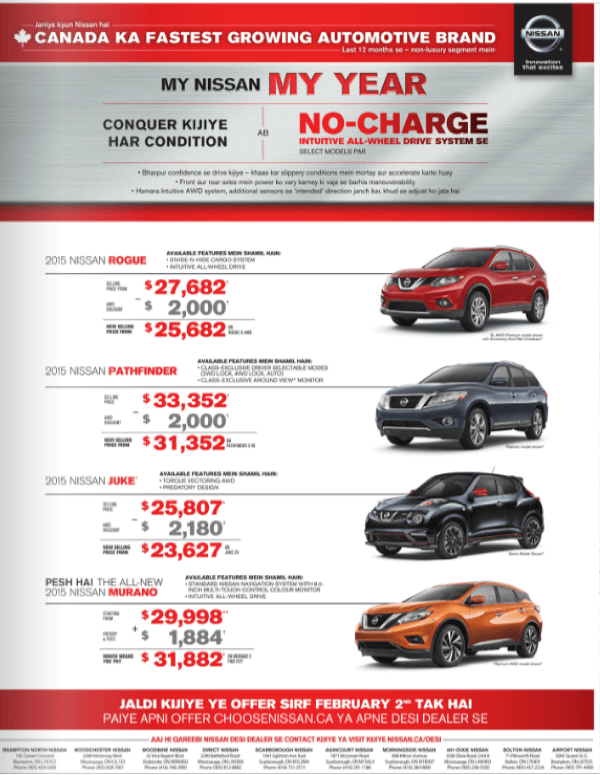For those working in multicultural marketing in Canada, one of the topics they most frequently want to understand is language. When it comes to targeting South Asian Canadians, the number of questions increase. South Asia is home to several hundred languages. And that doesn’t even touch on when “Hinglish” and more casual colloquial styles may be appropriate.
In our book, Migration Nation, we argue that there are two factors to consider when deciding on language in multicultural advertising: relevance and comprehension. Comprehension is often not an issue for the South Asian population in Canada. Apart from a minority of older, non-English/French speakers, the majority of South Asians are highly proficient in English. Use of a South Asian language, however, can dramatically increase the perceived relevance of communication.
A friendly word in someone’s mother tongue is a great way to make a connection. But you have to get it right. It doesn’t take too much to do so. Some investigation into the population and hopefully a little research to check the creative should do it.
So, with that in mind, let’s take a look at a recent Nissan Canada print ad and the Nissan Desi website.

This campaign appears to be targeted at the general South Asian Canadian population. It is using the kind of cocktail of South Asian languages (usually Hindi) and English that are expressed colloquially. Use of this “Hinglish” is a popular means for companies to speak to South Asians in a “friendly voice.” One challenge, however, is that Hinglish was never meant to be a written language so there can be comprehension difficulties. Another challenge is that it is not always appropriate. People may be happy to hear it from their friends, but not necessarily from their car dealership.
“One challenge, however, is that Hinglish was never meant to be a written language so there can be comprehension difficulties. Another challenge is that it is not always appropriate.”
Language Difficulties
To compound that, the language used by Nissan leans heavily towards Urdu. That’s a strange choice given that many South Asian Canadians do not speak Urdu. And the choice of using Romanized text rather than the Nastaʿlīq writing style commonly used for Urdu is an additional challenge. Even for many Urdu speakers, that may come across as awkward.
In an informal poll of 20 South Asian Canadians conducted by Environics Research Group (who by no means represent the entire South Asian Canadian community), they said:
- They were happy to see a South Asian specific initiative from Nissan
- Some elements such as a “Desi Dealer” tab on the website were especially appreciated
- But… the language sabotaged the effort
What the Multicultural Campaign Meant to South Asian Canadians
Some of those surveyed recognized some words that are common to Hindi and Urdu and assumed it was in Hindi. For example one person said, “Reading Hindi words in English makes for a ‘something’s off’ user experience. Besides that, the fact that a multi-billion dollar organization, Nissan, is making special efforts to appeal to ‘Desi’ folks is definitely attractive.”
Others felt like it was a nice effort but ultimately wasn’t inclusionary for the majority of South Asian Canadians saying things like:
I like that there’s a specific website for Desi people. However, some of the words (like “Taza Offers” or “Zaroori Links”) seemed like forced translations. Also, the headlines on the images are very heavy on Urdu. Even as a fluent speaker, I find this to be very specific and exclusionary for a Canadian Desi audience. The language also sounds very Pakistani, as opposed to something that could appeal to a large, South Asian diaspora.
Hard to read since I am not very well-versed in Urdu. Can understand many of the common words from Hindi language, which is what we speak in India. I am more comfortable reading in English. Faster and easier to understand since some words can be pronounced differently in Hindi when written in English alphabet on this site. Felt this was more for a Pakistani audience or those who speak/understand Urdu.
As a result, more of those we polled said they felt more negative to Nissan after seeing this communication than positive. That, of course, is not what any campaign hopes to achieve.
“This may not be the kind of representative survey we usually conduct to evaluate marketing campaigns, but it is enough to raise a serious red flag.”
If this straw poll reflects the views of the general South Asian Canadian population, Nissan Canada may not only be wasting its multicultural marketing investment, but also potentially damaging its brand.
On the one hand, Nissan Canada should be applauded for its multicultural marketing efforts; from the limited feedback we have, the South Asian Canadian population welcomed targeted communication.
There is no doubt that this kind of multicultural marketing initiative is a great asset for the company in building its brand relationships. That is because like anything that touches on culture and identity, it will resonate with the target consumer. But it also shows that language missteps can undermine the initiative, if companies don’t ensure the language and communication they’re using is indeed correct for their target audience. If that happens, instead of aiding comprehension and relevance, they can hinder it.
Robin Brown is Senior Vice-President, Consumer Insights at Environics Research Group, a research and consulting firm and co-author of the book “Migration Nation: A Practical Guide to Doing Business in Globalized Canada.”




